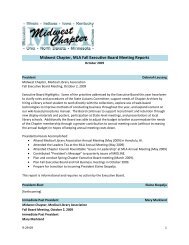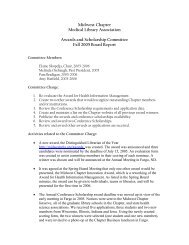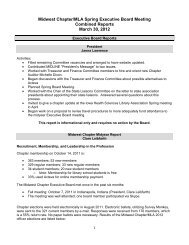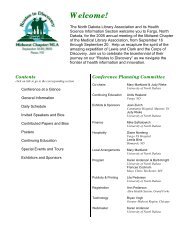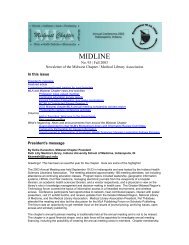full conference program - Midwest Chapter MLA
full conference program - Midwest Chapter MLA
full conference program - Midwest Chapter MLA
You also want an ePaper? Increase the reach of your titles
YUMPU automatically turns print PDFs into web optimized ePapers that Google loves.
Sunday, October 7 th , Session 1<br />
2:05-2:20 McDonnell Suite<br />
Contributed Papers Abstracts<br />
Integrating Library Instruction into an Evidence-Based Dental Practice Course<br />
Author: Barbara A. Gushrowski, MLS, AHIP, IUSD Library.<br />
Before dental students can engage in evidence-based dental practice (EBDP), they must first understand the core<br />
concepts. The librarian worked with a dental school faculty member to develop a 7-hour EBDP module for first year<br />
dental students. The module is delivered in the first weeks of school and consists of short lectures, small-group<br />
discussions, and in-class exercises. Students are instructed on the rationale for EBDP, characteristics of research design,<br />
sources and levels of evidence, the process of converting information needs into clinical questions, and, ultimately,<br />
searching the medical literature to find the evidence. Students are introduced to the PICO format to formulate clinical<br />
questions then are given patient scenarios to practice developing their own clinical questions. Students receive<br />
instruction in the use of the library’s information resources via eight short videocasts which they view outside of class.<br />
The students complete individual assignments to demonstrate their ability to use the resources to locate information.<br />
The principles introduced in the module are reinforced with additional assignments throughout the summer and fall<br />
semesters in Problem-Based Learning (PBL) small group sessions. The students also complete four assignments<br />
throughout the semester in which they list the information resources used to answer a question, rate the resources, and<br />
reflect on the search process. This module provides the dental students with a foundation on which they can build<br />
expertise in applying EBDP principles first with PBL ‘paper’ patients and ideally, transferring their skills into the clinical<br />
setting.<br />
2:20-2:35 McDonnell Suite<br />
The Evolving Role of the Librarian in a Family Medicine Clerkship<br />
Authors: Anne Beschnett , Jonathan Koffel, and Jim Beattie, Liaison Librarians, Bio-Medical Library, University of<br />
Minnesota.<br />
Objective: To discuss how liaison librarians collaborated with medical faculty to raise the perceived value and<br />
effectiveness of a librarian/faculty-led class and assignment and develop a more involved and appropriate role for the<br />
liaisons in a family medicine rotation for third and fourth year medical students.<br />
Methods: A small group of liaisons at a <strong>Midwest</strong>ern biomedical library have collaborated with Family Medicine faculty<br />
for several years to teach a session on evidence-based practice and health literacy and assess the related assignment.<br />
Feedback from students showed that many felt it was just "another PubMed class" and did not see its value and their<br />
assignments often reflected this lack of interest. To address this, the librarians reviewed the feedback, drafted a<br />
proposed set of changes, and then met with the faculty to review the changes and redesign the didactic portion to focus<br />
more on discussion and problem solving. In addition, they suggested ways to get librarians more involved with the<br />
project assessment and evaluation portion. These changes were summarily accepted by the faculty and put into<br />
practice. The success of the changes was evaluated based on feedback from faculty, students, and librarians and a<br />
review of the quality of submitted assignments.



